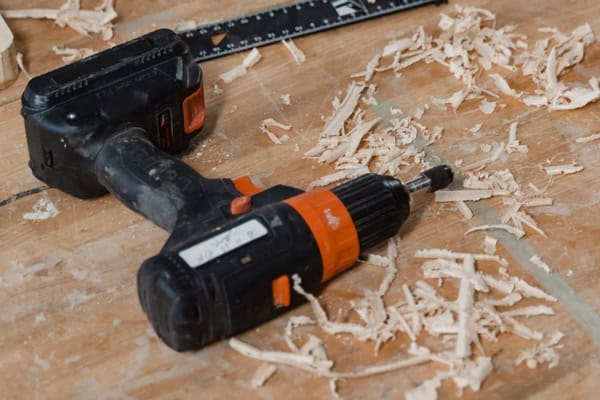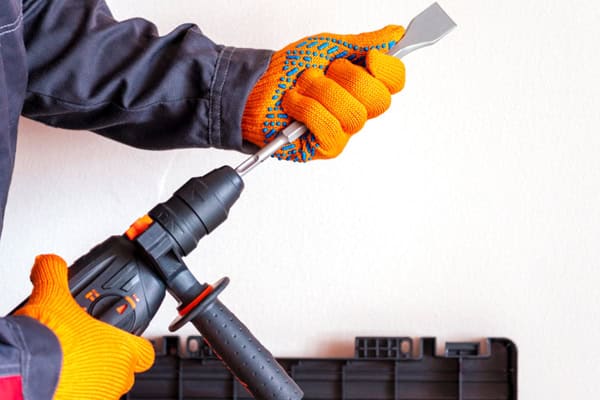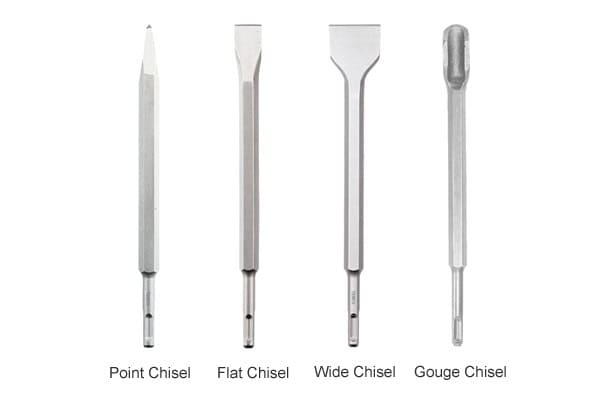Are you staring at a concrete wall, dreaming of demolition? Or maybe you need to remove some stubborn tiles? An SDS drill with a chisel attachment might be your new best friend!
This article will show you how to use an SDS drill with a chisel, and why it’s the right tool for tough jobs.
Using an SDS drill with a chisel is effective for breaking through tough materials like concrete and masonry. First, choose the right chisel, secure it in the SDS drill, and set the drill to "hammer" or "chisel" mode. Let the drill do the work, applying steady pressure to avoid slippage.

Ready to learn more? Let’s dive into the specifics of using an SDS drill1 with a chisel, including the right chisels2, how it compares to other drills, whether you can use it for regular drilling, and even whether you can use chisels with a regular hammer drill3!
Can you Chisel with an SDS Drill?
Ever wondered if your SDS drill could do more than just drill holes? The answer might surprise you.
Yes, you can definitely chisel with an SDS drill! SDS drills are designed for heavy-duty tasks, and with the right chisel attachment, they can make quick work of concrete, brick, and tile removal. Just switch to the hammer mode.

SDS drills are great for chiseling because they deliver a powerful hammering action4. This makes it easier to break through hard materials. However, you need to make sure you’re using the correct settings and techniques5.
Here’s a breakdown of key considerations:
Different Types of SDS Chisels
There are several types of SDS chisels, each designed for a specific purpose:
| Chisel Type | Utilisation |
|---|---|
| Burin plat | Removing tiles, surface removal, general demolition |
| Pointed Chisel | Precision breaking, starting holes, detailed work |
| Gouging Chisel | Cutting channels in masonry |
| Ciseau large | Removing roughcasting, dirt, and concrete residue |
Mastering the Chisel Technique
When chiseling, let the drill do the work. Avoid applying too much pressure, which can cause the chisel to slip or break. Keep the drill steady and maintain control.
I remember when I was removing some old tiles in my kitchen, I tried to rush the job by forcing the chisel. I ended up damaging the subfloor. I learned that patience and letting the tool do the work is key.
What is a SDS chisel?
Okay, so we know you boîte chisel with an SDS drill, but what exactly is an SDS chisel?
An SDS chisel is a specialized tool designed for use with SDS drills. It has a unique shank that locks into the SDS chuck, allowing the drill to deliver a powerful hammering action directly to the chisel tip.

SDS stands for "Slotted Drive System6." This refers to the way the chisel connects to the drill. Unlike regular drill bits that are held in place by tightening a chuck, SDS chisels have slots that fit into grooves in the SDS chuck7. This creates a secure connection that can withstand the force of the hammer action.
Here’s what makes SDS chisels stand out:
Secure Connection Matters
The SDS chuck system ensures that the chisel doesn’t slip or rotate8 during use. This is important when you’re working with tough materials9 that require a lot of force.
Power Transfer Is Key
The direct connection between the drill and the chisel means that more of the drill’s power is transferred to the chisel tip. This makes it easier to break through hard materials.
Built to Last
SDS chisels are made from hardened steel, so it can withstand the heavy use. They are designed to last, even when used on tough materials like concrete and stone.
I remember one time when I was helping a friend demolish a concrete patio. We were using regular chisels and a sledgehammer, and it was taking forever. I suggested we try an SDS drill with an SDS chisel. It made the job so much faster and easier!
Is a SDS Drill Better than a Hammer Drill?
Choosing the right drill can be confusing. Are SDS drills and hammer drills the same? Which one should you choose?
SDS drills are generally better for heavy-duty tasks like breaking concrete, while hammer drills are more versatile for lighter tasks. SDS drills have a more powerful hammering action, making them more efficient for tough materials.

The main difference between SDS drills10 et hammer drills11 lies in their mechanism and power. Hammer drills use a percussive action to help the drill bit penetrate hard materials, but SDS drills have a more forceful, piston-driven hammer action.
Here’s a comparison:
| Caractéristique | Marteau perforateur | SDS Drill |
|---|---|---|
| Hammering Action | Less powerful, relies on pressure from the user | More powerful, piston-driven |
| Chuck Type | Standard chuck | SDS chuck (slotted drive system) |
| Bit Compatibility | Standard drill bits, masonry bits | SDS bits only |
| Best For | Lighter tasks, DIY projects | Heavy-duty tasks, concrete, masonry |
| Precision | More control and precision | Less precise, more focused on power |
| Durabilité | Less durable for heavy use | More durable for demanding applications |
I’ve used both types of drills, and I can tell you that there’s a big difference when it comes to drilling into concrete. A hammer drill will eventually get the job done, but an SDS drill will power through it with ease.
As a wholesale supplier, tenyu recognizes the importance of providing tools that meet the demands of various projects. SDS drills, with their robust design and compatibility with SDS chisels, are a must-have for professionals and DIY enthusiasts tackling tough materials.
Can You Use SDS Chisels in a Regular Hammer Drill?
While chisel bits are best used in hammer drills for heavy-duty tasks, you can’t use SDS chisels in a regular hammer drill without an adapter. You’ll need an SDS drill or a drill with an SDS chuck adapter.
You’ll need either an SDS drill or a drill that has an SDS chuck adapter. These adapters turn regular drills into SDS drills, giving you the features of an SDS drill. I have found that using the correct tools not only makes the job easier but also extends the life of my equipment.
Can you Use an SDS Drill for Normal Drilling?
Now, can your SDS drill pull double duty? Can it handle the regular drilling tasks around the house?
Yes, you can use an SDS drill for normal drilling, but you’ll need an adapter to use regular drill bits. Also, remember to switch off the hammer mode to avoid damaging the material you’re drilling.
While SDS drills are designed for heavy-duty work, they can be adapted for normal drilling tasks with the right accessories and settings. The key is to use an SDS to standard chuck adapter.
Here’s what you need to know:
The Right Adapter is Essential
This adapter allows you to use regular drill bits with your SDS drill. It fits into the SDS chuck and provides a standard chuck for holding the drill bits.
Hammer Mode OFF for Delicate Work
When drilling into wood, metal, or plastic, it’s important to turn off the hammer mode. The hammering action can damage these materials.
Control the Speed for Precision
SDS drills often have variable speed settings. Use a lower speed for delicate tasks and a higher speed for tougher materials.
I once tried to drill a small hole in a piece of wood using my SDS drill in hammer mode. The result was a mess of splintered wood and a ruined project. I quickly learned that turning off the hammer mode is essential for normal drilling.
Conclusion
So, can you use an SDS drill with a chisel? Absolutely! It’s a powerful combination for tackling tough materials. Just remember to use the right chisel, settings, and techniques.
-
Understanding the mechanics of an SDS drill can enhance your drilling efficiency and project outcomes. ↩
-
Choosing the right chisels can significantly improve your work quality and speed, making your projects easier and more effective. ↩
-
Exploring this topic can help you maximize the tools you already have and understand their limitations better. ↩
-
Learn how powerful hammering action enhances chiseling performance, making it easier to work with tough materials effectively. ↩
-
Discover the essential settings and techniques for using SDS drills to maximize their effectiveness and ensure safety during chiseling. ↩
-
Understanding the Slotted Drive System can enhance your knowledge of drilling technology and improve your tool selection. ↩
-
Learning about the SDS chuck will help you understand its role in securing chisels and improving drilling efficiency. ↩
-
Learn techniques to secure your chisel effectively, ensuring safety and precision in your work. ↩
-
Explore expert tips and techniques for handling tough materials to achieve better results in your projects. ↩
-
Explore this link to understand the unique features and advantages of SDS drills over traditional options. ↩
-
Learn about hammer drills’ mechanisms and their best uses to enhance your drilling projects. ↩